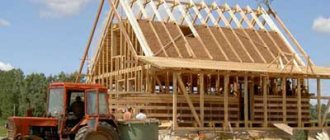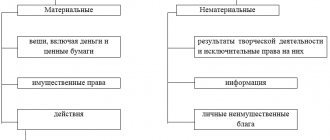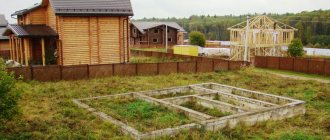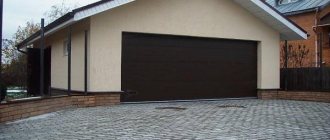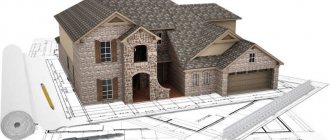Capital construction project - what is it?
The definition of the term is prescribed in the Town Planning Code of the Russian Federation. A capital construction project is any unfinished structure for the construction of which foundation work is being carried out. For example, from laying the foundation to putting it into operation, a new residential building is a capital construction project. After commissioning and registration, the object becomes a permanent structure.
In turn, a capital structure is a finished residential or non-residential building, or structure inseparably connected with the site on which it is located. Such a structure cannot be dismantled and moved to another site while maintaining its main characteristics.
For comparison, a non-permanent structure can be disassembled, transported, assembled at another location and used for its intended purpose. Such objects include kiosks, sheds, temporary shelters, container-type structures and other light temporary buildings.
Capital or temporary nature - let’s look at the nuances
As such, you will not find the concept of “capital construction” in the current GOST of Russia, while the regulations provide for the definition of categories of buildings.
- Category I - this type of building must have a service life of over 100 years.
- Category II - this category of objects has a service life of 50-100 years.
- Category III - this type of object must have a service life of 25-50 years.
- Category IV - the service life of the facility is 5-25 years.
For the last class of object, there is an unwritten rule of the concept of a temporary nature, and this type of building must be built on the basis of lightweight structural materials - wooden structures or other types.
Types of capital construction projects
It should be noted that construction projects differ by type. You also need to know that capital construction requires the approval of SRO builders.
First view - building
Buildings are divided into two large categories - residential and non-residential. A non-residential building is a building whose purpose is to create conditions for work, social and cultural services for the population and storage of material assets: industrial, agricultural, commercial, administrative, educational, healthcare, and so on. The main feature of buildings is that they are intended exclusively for human habitation. There are several subspecies here:
- Residential building or house
This is a building consisting of rooms and additional premises for auxiliary use, designed to provide citizens with household and other needs related to their residence in such a building. Residential buildings or houses include permanent residential buildings, dormitories, shelters, boarding houses for the elderly and disabled, veterans, orphanages, boarding schools at schools and other houses.
- Individual residential buildings
They are detached residential buildings with no more than three floors, intended for one family. They also include cottage-type houses (which have a small plot of land).
- Cottages
These are individual residential buildings, mostly two-story with an internal staircase. On the ground floor there is usually a common room, kitchen, and utility rooms; on the second floor there are bedrooms, single-apartment blocked residential buildings consisting of autonomous residential blocks, and so on.
- Apartment house
It consists of two or more apartments in a residential building that has independent access either to a land plot adjacent to a residential building or to common areas in such a building. An apartment building, in accordance with housing legislation, contains elements of the common property of the owners of the premises. Agricultural construction site.
Accounting for OS restoration work
Costs for the reconstruction of fixed assets are accounted for in account 106.01 “Investments in fixed assets” (clause 130 of the Instructions to the Unified Chart of Accounts No. 157n).
We present the main correspondence that must be reflected in the accounting in the table.
Table “Correspondence of invoices for asset reconstruction operations”
| Dt | CT | Contents of operation |
| 0.106.ХХ.310 | 0.105.ХХ.440 | expenses for reconstruction are taken into account in the amount of material reserves written off for the work |
| 0.106.ХХ.310 | 0.302..730 0.302.26.730 | the costs of reconstruction of fixed assets carried out by contract are taken into account |
| 0.101.11.310 | 0.106.11.310 | the initial cost of the fixed asset was increased by the total amount of reconstruction costs. |
This procedure is established by the Instructions to the Unified Chart of Accounts No. 157n (accounts 101.00, 106.01, 302.00).
The costs of repairs, including capital ones, with the involvement of a third-party organization are reflected in accounting by the entries shown in Table 2.
Table 2. Correspondence of invoices for OS repair operations
| Dt | CT | Contents of operation |
| 0.401.20.225 | 0.302.25.730 | Remuneration accrued to the contractor for repairs |
| 0.302.25.830 | 0.201.11.610 Off-balance sheet account 18 | Payment transferred to the performer |
Differences between capital and non-capital buildings
When commissioning, a capital structure must undergo state registration; the documents for the facility indicate its main characteristics, address, area, purpose, compliance with SNiP standards, fire safety and other requirements. Additional criteria for assessing a capital structure include:
- type of design and technical solutions;
- used building materials;
- size and location of the object;
- level of improvement.
Documenting
It is recommended that the need for repair work be documented. If an organization is repairing operating systems that are already in use, then it is possible to draw up a report on the identified defects of the fixed asset (defect sheet). Repairs of new equipment, the malfunction of which was identified before being registered as a fixed asset, must also be documented.
Order of the Ministry of Finance of the Russian Federation dated March 30, 2015 No. 52n does not provide for the form of the primary document for these purposes. But you can draw up a report on identified equipment defects in form No. OS-16 (OKUD 0306008). Its use must be fixed in the accounting policy, because now the forms of documents of class 03 according to OKUD are not mandatory.
For some industries, unified departmental forms of supporting documents are provided. For example, in order to document identified defects in lifting and transport equipment of sea trade ports, they use a defect sheet approved by Resolution of the Ministry of Transport of the Russian Federation dated January 09, 2004 No. 2.
When transferring an asset for repair to a special department of the institution (for example, a repair service), you should draw up an invoice for internal movement (form 0504102) in triplicate. If the location of the asset does not change during repairs, there is no need to prepare an invoice. This procedure follows from the Methodological Instructions approved by Order of the Ministry of Finance of the Russian Federation dated March 30, 2015 No. 52n.
If an organization does not carry out repair work on its own, it is required to conclude a contract with the contractors (Article 702 of the Civil Code of the Russian Federation).
When transferring a fixed asset to a contractor for long-term repairs, you need to draw up an act of acceptance and transfer of the fixed asset. In general, the Methodological Instructions approved by Order of the Ministry of Finance of the Russian Federation dated March 30, 2015 No. 52n, say that when transferring an object of fixed assets, it is necessary to draw up an acceptance certificate in form No. 0504103. But if you pay attention to the details of the act itself (f.0504103), you can see that it will not be possible to fill it out during transfer. Since the beginning of the act contains the following text:
“The commission, appointed by order (instruction) dated “_” ____ 20_, inspected the repaired, reconstructed, modernized fixed assets and established the following:..”
Consequently, subsequent sections of the deed are completed after the contractor has already delivered the repaired property. Therefore, when you are just handing over an object for repairs, you can draw up an act in any form.
In the event of damage (loss) of a fixed asset item, the signed act will allow the institution to demand compensation from the contractor for damages caused (Articles 714 and 15 of the Civil Code of the Russian Federation). If there is no such act, then it will be difficult to prove the transfer of this fixed asset to the contractor.
After signing the act (f.0504103), the head of the institution approves it, then the act is transferred to the accounting department. Based on the received report, the accountant needs to reflect information about the repairs performed in the fixed asset inventory card according to form No. 0504031 (No. 0504032). There is no need to make accounting entries for changes in the value of an object.
It is recommended to formalize the decision on the reconstruction of fixed assets by order of the head of the institution, which must indicate:
- reasons for reconstruction;
- timing of its implementation;
- persons responsible for the reconstruction.
Where can capital construction be carried out?
The selection of a site for the construction of a particular facility is based on the classification of types of permitted land use. According to this classification, all areas must be used according to their intended purpose. For example, certain territories are allocated for agriculture, entrepreneurship, manufacturing, residential development, construction of public and cultural facilities, and transport. At the same time, several types of activities may be permitted on one site. It is allowed to erect a permanent structure on any plot of land in accordance with its purpose, with the exception of lands of the environmental complex and protected areas, where any capital construction is prohibited.
Is a bathhouse a permanent structure or not?
The answer depends on the construction features and the size of the facility. One-story baths on a light, shallow foundation or installed on several supports are classified as temporary buildings. Often such a structure can be purchased already assembled and installed on the site without excavation work. A bathhouse with an area of more than 20 m2 with a buried foundation, with all the necessary communications and additional rest rooms is recognized as a permanent structure. The same criterion is used to evaluate a steam room attached to a residential building.
Is a garage a permanent structure or not?
A container-type garage is a temporary structure: it can be easily transported from place to place and installed on a compacted area or crushed stone embankment. A brick garage with a basement and an overpass is a permanent structure; excavation work was carried out during its construction.
Bathhouse registration
You need to register capital buildings, regardless of their purpose, if you want them to be your property. The right of ownership gives the opportunity to dispose of property in full. In the future, you can easily sell, donate, inherit, and even insure the built bathhouse.
Modern legislation allows you to register ownership of objects located on a purchased or received land plot. This could be a bathhouse and garage, animal enclosures, gazebos and utility blocks, garden and country houses, residential cottages.
Whether to register a bathhouse, garage and other similar buildings is up to each owner to decide for himself. Note that if this is a light structure without a solid foundation up to 1 meter deep, utility networks and living quarters, there is no point in registering. Moreover, you need to pay a separate tax for each registered object!
In this case, the bathhouse is one of the outbuildings that automatically become property along with the land plot. Of course, if the plot itself is registered as a property. Therefore, whether an object needs registration depends on its type and purpose. You can choose a solid capital structure or a compact building. You will find many interesting projects of bathhouses with one and two floors, with recreation rooms, a terrace and an attic in the catalog of the MariSrub company.
Registration is required for a bathhouse with communication networks, living quarters, a deep foundation, i.e. if it is a permanent structure. Also subject to registration are bathhouses attached to a residential building or buildings whose layout includes a bathhouse inside the house.
The difference between OKS and real estate
In fact, the definition of OKS in the Civil Code of the Russian Federation comes from the opposite, that is, capital objects recognize all those that are not classified as non-capital. It turns out that indirectly OKS and real estate are one and the same thing:
The property is firmly connected to the ground and has a foundation. It cannot be moved or dismantled, since all its components are indivisible, they cannot be used separately without violating the integrity of the entire object, its purpose and functions. Ownership of real estate is subject to registration.
The same can be applied to ACS.
- Real estate includes all capital construction projects (Article 130 of the Civil Code of the Russian Federation). (Structures are registered as buildings). Legally, housing estates and real estate are not the same categories:
- In addition to being tied to the land, the objects complying with technical parameters, urban planning standards and other requirements, to create a real estate property, ownership of the land plot, the consent of the owner of the land plot or permission from the executive authorities is required.
- Utilities must be connected to the property, while during the construction of capital construction projects this is not always a necessary condition.
Is it even possible to build?
Even a small bathhouse 2.3x6 meters cannot be taken and placed anywhere, only taking into account the planned development. Construction of such facilities is carried out only on lands of certain categories:
- plots of gardening partnerships and dacha cooperatives;
- personal plots for subsidiary farming;
- plots for individual housing construction.
If everything is fine with the category of land, you can order development or choose a ready-made standard project. Based on its features, you will determine what to do next.
Permit for construction of OKS
Based on Art. 51 for the construction of an OKS, except for the cases specified in paragraph 17 of this article, it is necessary to obtain permission. It can be issued only if the rules of land use and construction are observed (except for those objects that are not subject to (or are not established by) the requirements specified in the town planning regulations).
On the territory of airfields, restrictions are established on the use of OKS, that is, any facility cannot be built there.
You do not need permission:
- for the construction or reconstruction of individual housing construction, residential buildings, garages, garden houses, auxiliary buildings on a land plot;
- overhaul and reconstruction of the OKS (if it does not lead to a change in its purpose);
- construction of boreholes, gas pipelines, according to state technical projects;
- in other cases specified in paragraph 17 of Art. 51 Civil Code of the Russian Federation.
Non-capital construction projects
These include temporary buildings and structures.
Temporary buildings
Temporary buildings are erected or converted from other buildings and structures for construction and installation work:
- prefabricated flat-linear structures that are easy to install and disassemble;
- containers;
- mobile objects.
At first glance, such buildings may be no different from capital ones: they may have a solid foundation, stone walls, reinforced concrete floors. You can understand what an object belongs to (a permanent or non-permanent structure) by its temporary purpose (the service life of a temporary structure is usually up to 5 years, sometimes up to 15), and when construction stops, it must be dismantled. However, this does not always happen, and some temporary buildings actually turn into permanent ones.
Temporary buildings are also being erected in forestry and agricultural lands: warehouses, beehives, sheds, buildings for animals, equipment storage, etc.
Non-permanent structures
These are structures made of lightweight structures, without a foundation (or installed on a shallow ground foundation), without underground premises or utilities: kiosks, pavilions, playgrounds and observation decks, fountains, outdoor toilets, etc.
There is no need to obtain permission to construct non-permanent buildings. They are not subject to registration of property rights and taxation.
An important advantage of OKS is the opportunity to become its owner. The capital construction project is being built thoroughly and for a long time. At the same time, such facilities are subject to increased requirements and may require a building permit.
A public housing complex, which is an unauthorized construction, can be demolished or registered with the owner of the land plot on which it was built, if it complies with urban planning standards.
A capital construction facility that became such as a result of the reconstruction of another facility is also an unauthorized construction.
What documents are required to be prepared?
The following documents are presented:
- applicant's passport;
- title documents for land: privatization act, alienation agreement, certificate of accession to the rights of an heir, etc.;
- extract from the Unified State Register of Real Estate;
- site and building plans indicating the distance to the nearest objects.
In case of registration under the dacha amnesty, land documents are not required.
Classification of capital construction projects by functionality
Linear objects are structures for which certain operating conditions must be observed. These include, for the most part, infrastructure facilities: highways, pipelines, roads, power lines, tunnels.
Before the start of construction of a linear facility, all technical documentation is studied directly on the territory, and specialized equipment is used for geological and construction surveys and land surveying. A permit to carry out construction work is issued only after completing a package of necessary documents and agreement with the authorities.
Production and industrial structures include capital buildings erected for operation in agriculture and water management, trade, industry, transport, in the field of sales and logistics, communications, and public catering. Their goal is material production. These also include linearly extended objects.
Non-production facilities are administrative buildings, healthcare institutions, cultural and educational facilities, housing and communal services, and social facilities. Their goal is to provide cultural and everyday services.
There is also a definition of structures of defensive significance - these include buildings and structures necessary to ensure the security of the country.

